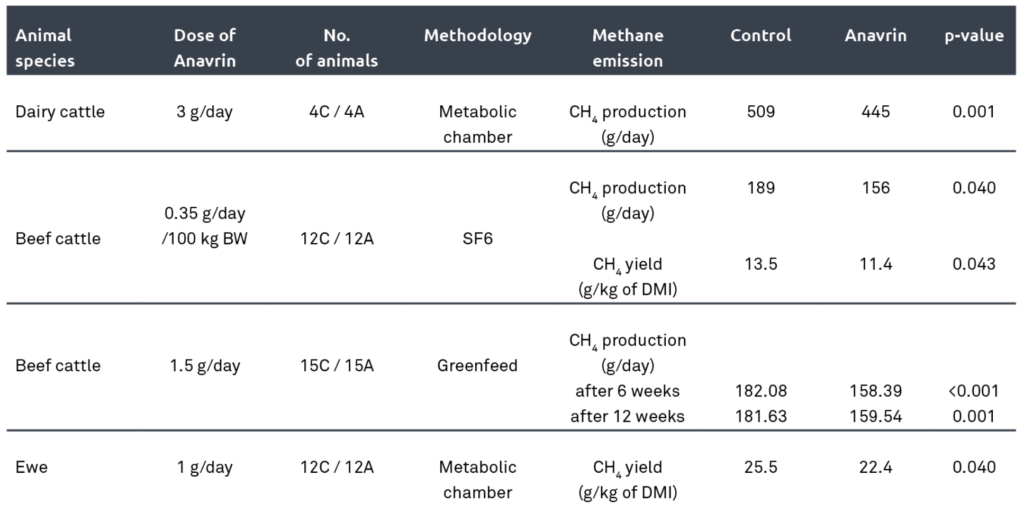Ruminants have been playing a valuable part in the human food chain for centuries. Their ability to produce highly valuable food products – like milk and meat – out of inedible plant materials makes them a quality asset in our food chain. Today, the increasing demand for milk and meat is compelling the livestock sector to increase its production. However, the sector is also facing growing challenges concerning its negative impact on the environment via nitrogen deposition and the contribution of ruminant production to greenhouse gas emissions.
Rumen fermentation feeds the animal and produces methane
The valuable contribution of ruminants to the human food chain stems from their fermentative digestion of fibrous material before this is digested in the stomach and intestines. The vast population of bacteria, protozoa and fungi in the rumen use the feed eaten by the ruminant as substrate for their growth and development. During this fermentation, by-products become available that form the basis for the ruminant’s nutrition. In essence, we feed the rumen microbiome to accomplish the rumen fermentation that feeds the animal.
Dairy and beef cows are the main ruminants in the modern food chain (next to small ruminants like goats and sheep). More and more attention is being paid to their contribution to greenhouse gas emissions in the form of methane (CH4), which is an intrinsic part of rumen fermentation.
Managing hydrogen levels in the rumen
During the fermentation by ruminal microbes, volatile fatty acids (VFA) are produced in addition to hydrogen (H2) and carbon dioxide (CO2). The VFA are then absorbed by the rumen wall to serve as the animal’s main energy source, while the gases must be removed from the rumen to ensure the continuation of rumen fermentation. The production of methane from H2 and CO2 is the major pathway to managing the hydrogen levels in the rumen.
Methane emission is a natural consequence of fermenting fibrous plant material – and for the host animal, it results in an energy loss of 2-12% (Johnson and Johnson 2022).
In addition to the production of methane, there are multiple ways to manage the hydrogen levels during rumen fermentation. One of the most promising ways is to shift VFA production during rumen fermentation by increasing the proportion of propionic acid. The production of propionic acid consumes hydrogen in contrast to the production of acetic and butyric acid. This shift increases feed efficiency; and milk production is also supported by increased propionic acid, which is known to be the major contributor to the energy pool for milk production. In this way, we can turn methane reduction into a benefit for the cow, the farmer and the environment.

Anavrin® contributes to reducing methane in ruminants
Anavrin® is a feed supplement specially designed to improve milk production (Table 1) and feed efficiency (Figure 2), while reducing methane in ruminants (Table 2).
The mode of action is based on a shift in rumen fermentation, which results in greater propionic acid production as well as both direct and indirect inhibition of methane production. A direct effect involves inhibiting the methane-producing microbes in the rumen, and an indirect effect is the reduction of the hydrogen level during rumen fermentation by the increased production of propionic acid. Thus, Anavrin® brings a positive contribution to the cow, the farmer and the environment, while reducing methane in ruminants.
Table 1: Impact of Anavrin® on milk production and feed conversion in dairy cows (Carlo Angelo Sgoifo Rossi et al., Animals 2022-12)
| Control | Treatment | p-value | |
|---|---|---|---|
| Milk yield (kg/head/d) | 36.90 ± 0.23 | 38.30 ± 0.23 | <0.001 |
| ECM1 (kg/head/d) | 38.30 ± 0.52 | 40.20 ± 0.52 | <0.001 |
| DMI2 (kg/head/d) | 24.70 ± 0.08 | 24.10 ± 0.08 | <0.001 |
| FCR3 | 1.49 ± 0.01 | 1.58 ± 0.01 | <0.001 |
Data are presented as least squared means standard error of the means (SEM). 1 ECM = energy corrected milk; 2 DMI = dry matter intake; 3 FCR = feed conversion rate.

Table 2: Overview of the effect of Anavrin® on Methane (CH4) emission
